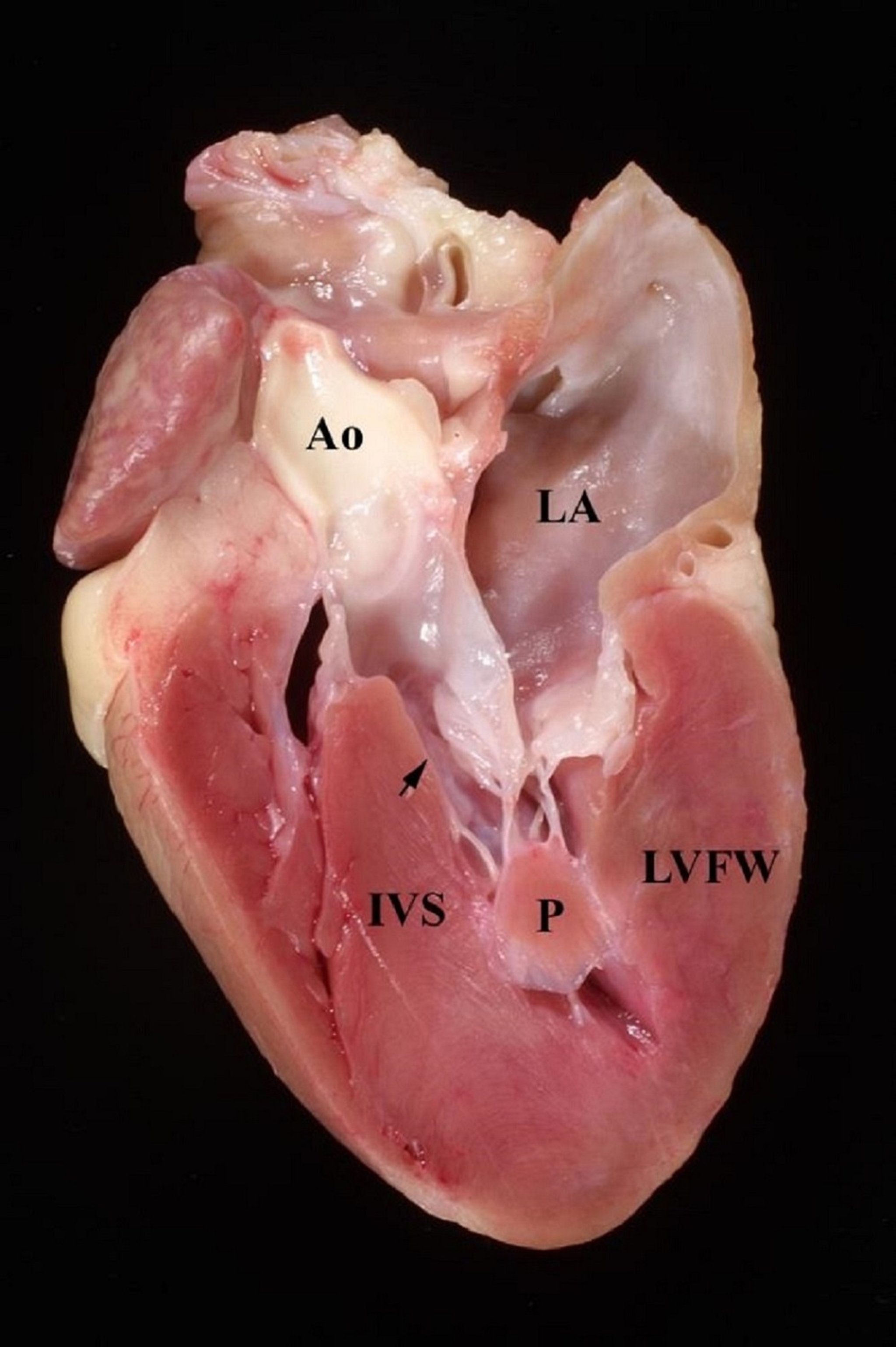Courtesy of Dr. Mark D. Kittleson.
Hypertrophic cardiomyopathy (HCM) is the most common heart disease of cats, affecting as many as one in seven (the vast majority of cases are subclinical). HCM is characterized by primary concentric left ventricular hypertrophy due to an inherent myocardial disorder, hormonal stimulation (such as hyperthyroidism or acromegaly), infiltration of the myocardium (eg, lymphoma), or other noncardiac disease. HCM occurs primarily in domestic cats and rarely in small dogs. It has also been reported in cattle. Papillary muscle enlargement is a consistent feature of the disease in cats. In humans, HCM is due to mutations in a number of sarcomeric genes. Mutations in one sarcomeric gene, the cardiac myosin-binding protein C gene, have been identified in Maine Coon Cats and Ragdoll cats. Maine Coon Cats that are homozygous for their (A31P) mutation are primarily the ones that develop clinically important HCM. Severe hypertrophy is often accompanied by cellular necrosis and resultant replacement fibrosis (myocardial scarring).
Many cats with HCM, especially those with mild to moderate disease, have no clinical signs. Cats that develop severe disease may also have no clinical signs; usually, however, they go on to develop left heart failure, systemic thromboembolism, or sudden death. Cats in heart failure have clinical signs of tachypnea and dyspnea secondary to pulmonary edema or pleural effusion; cough is uncommon in cats with heart failure. Cats with systemic thromboembolism most commonly have an acute onset of hind limb paresis/paralysis coupled with acute pain and weak or absent femoral pulses. Physical examination frequently demonstrates abnormal heart sounds, including a soft to prominent systolic cardiac murmur and/or a gallop sound. However, a heart murmur is not present in at least one-third of cats with HCM.
Radiographic evaluation may show pronounced left atrial enlargement and variable left ventricular enlargement, but the cardiac silhouette can appear relatively normal if the left atrium is not enlarged. Echocardiography is required to make a definitive diagnosis of HCM, upon which left ventricular wall thickening and papillary muscle hypertrophy are noted. Systolic anterior motion of the mitral valve may be present, creating murmur(s) consistent with aortic outflow obstruction and/or mitral regurgitation. The left atrium is usually severely enlarged and is at least moderately enlarged in all cats in left heart failure. ECG abnormalities may include supraventricular premature complexes, ventricular premature complexes, and ventricular tachycardia. The plasma concentration of NT-proBNP is often increased in cats with severe disease, particularly those in heart failure (see Cardiac Biomarkers).
Treatment of hypertrophic cardiomyopathy is directed at controlling clinical signs of CHF, improving diastolic function, and decreasing the incidence of systemic thromboembolism. Clopidogrel (18.75 mg/day per cat) is the only drug shown to decrease the incidence of systemic thromboembolism in cats. Beta-blockers should not be used as a matter of routine in cats with HCM, but atenolol does decrease systolic anterior motion of the mitral valve and should be considered when this abnormality is severe. ACE inhibitors have no apparent beneficial effect before the onset of heart failure.
The prognosis for cats with HCM is highly variable. Many mildly affected cats have a good longterm prognosis. Cats in CHF have a poor prognosis, with a median survival time of 3 months. HCM is familial in many breeds of cats, including Persians, Sphynx, Norwegian Forest Cats, Bengals, Turkish Vans, and American and British Shorthairs. The disease occurs in cats from 6 months to 17 years old, although most cats are middle-aged at presentation. HCM is not present at birth; it develops over time. Penetrance is often < 100%. Male and female cats are equally predisposed; however, males tend to develop more severe disease at an earlier age.
